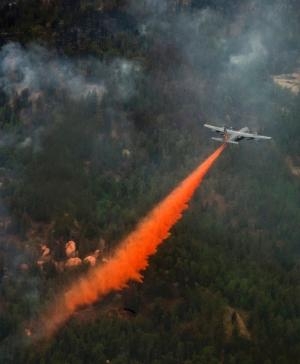Wed, Jun 26, 2013
Two Additional MAFF Aircraft From California Assist In Fire Suppression Effort
Two additional Modular Airborne Fire Fighting System-equipped military C-130 Hercules are joining the battle against wildland fires in Colorado. The U.S. Forest Service requested the additional aircraft through the National Interagency Fire Center in Boise, ID.

Two aircraft from the California Air National Guard's 146th Airlift Wing, based in Port Hueneme, CA, deployed Sunday to Peterson Air Force Base in Colorado Springs, CO. They join two C-130s from Air Force Reserve Command's 302nd Airlift Wing, based at Peterson AFB, which have been engaged in aerial firefighting for more than a week.
The two California aircraft bring the MAFFS fleet to four airplanes.
The request is in response to an increase in wildland fire activity in southern Colorado and neighboring states and the significant fire potential forecast for the coming week, officials said.
MAFFS initially activated June 11 to assist in fighting forest fires in southern Colorado after the Forest Service sent a request for assistance to the Defense Department through U.S. Northern Command. Since activating, MAFFS aircraft have made 36 drops using 93,830 gallons of fire retardant. MAFFS is a self-contained aerial firefighting system owned by the Forest Service. MAFFS modules are loaded into the cargo bays of military C-130 aircraft.
Led by small Forest Service planes, military aircrews can discharge 3,000 gallons of water or fire retardant from the MAFFS modules along the leading edge of a forest fire in less than five seconds and cover an area a quarter of a mile long by 100 feet wide. Once the load is discharged, ground crews at a MAFFS tanker base can refill the modules in less than 12 minutes.
A joint DOD and Forest Service program, MAFFS provides aerial firefighting resources when commercial and private air tankers are no longer able to meet the Forest Service's needs. A provisional military air expeditionary group controls the MAFFS resources at the Forest Service's direction.
(Image provided by the USAF)
More News
From 2023 (YouTube Version): Legacy of a Titan Robert (Bob) Anderson Hoover was a fighter pilot, test pilot, flight instructor, and air show superstar. More so, Bob Hoover was an i>[...]
Get The Latest in Aviation News NOW on Instagram Are you on Instagram yet? It's been around for a few years, quietly picking up traction mostly thanks to everybody's new obsession >[...]
Aero Linx: B-52H Stratofortress The B-52H Stratofortress is a long-range, heavy bomber that can perform a variety of missions. The bomber is capable of flying at high subsonic spee>[...]
Altimeter Setting The barometric pressure reading used to adjust a pressure altimeter for variations in existing atmospheric pressure or to the standard altimeter setting (29.92).>[...]
"Knowing that we play an active part in bettering people's lives is extremely rewarding. My team and I are very thankful for the opportunity to be here and to help in any way we ca>[...]
 Classic Aero-TV: Remembering Bob Hoover
Classic Aero-TV: Remembering Bob Hoover ANN FAQ: Follow Us On Instagram!
ANN FAQ: Follow Us On Instagram! ANN's Daily Aero-Linx (05.15.24)
ANN's Daily Aero-Linx (05.15.24) ANN's Daily Aero-Term (05.15.24):Altimeter Setting
ANN's Daily Aero-Term (05.15.24):Altimeter Setting Aero-News: Quote of the Day (05.16.24)
Aero-News: Quote of the Day (05.16.24)



